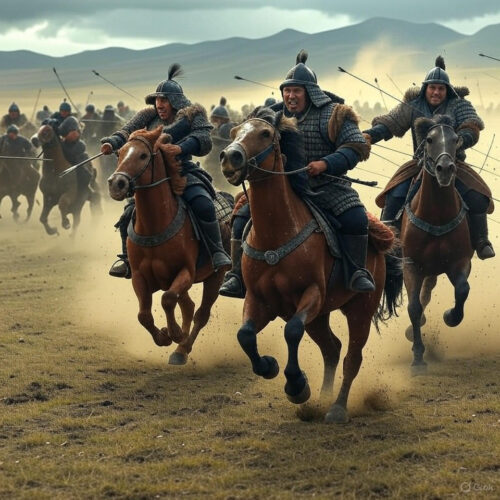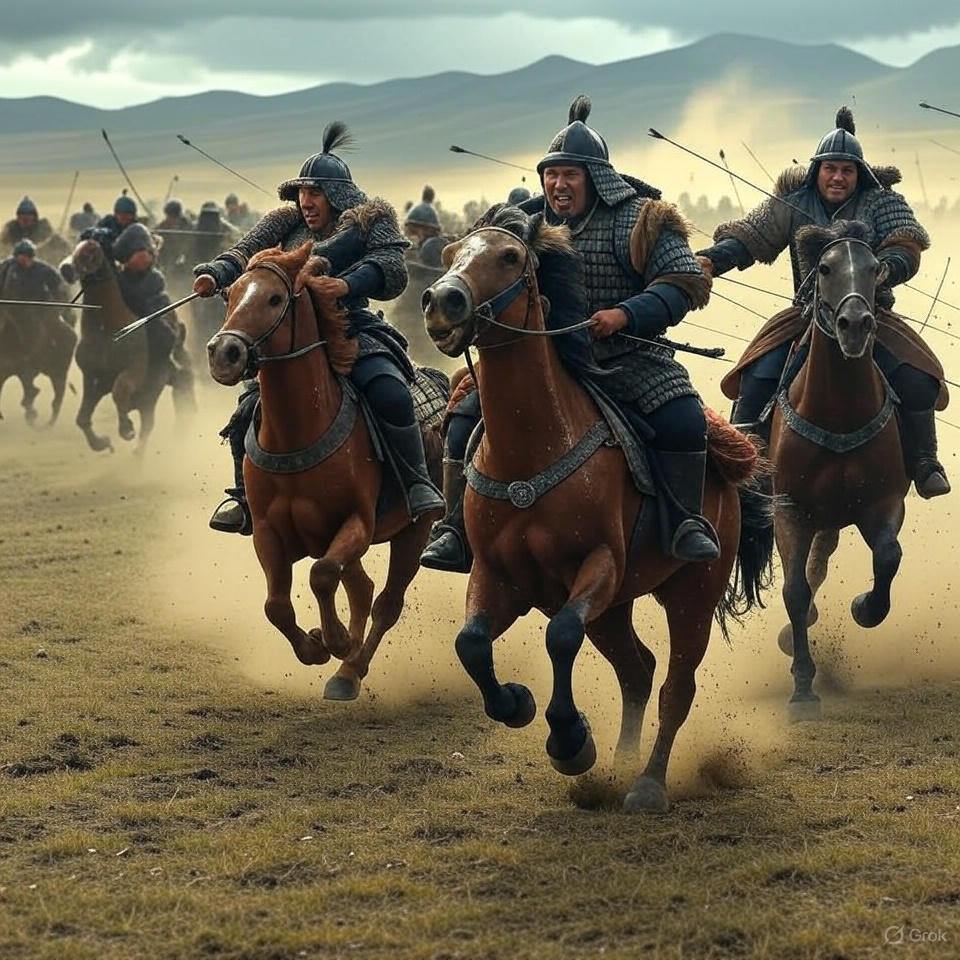Welcome to a journey through time, where the vast steppes of Mongolia meet the grand halls of ancient empires, and a single surrender changes the course of history. On this day, August 21, in the year 1264, a pivotal moment unfolded in the heart of the Mongol Empire at Shangdu—better known as Xanadu in poetic lore. Kublai Khan, the ambitious grandson of Genghis Khan, accepted the surrender of his younger brother Ariq Böke, marking the end of the Toluid Civil War. This wasn’t just a family feud; it was a clash that reshaped the largest empire the world had ever seen, leading to the establishment of the Yuan Dynasty in China and the gradual fragmentation of Mongol unity. In this blog, we’ll dive deep into the historical intricacies of this event, exploring the background, the key players, the battles, and the aftermath with rich detail. Then, we’ll bridge the centuries to show how the outcomes of this distant drama can inspire and empower you today, with practical applications to your life through specific strategies and a step-by-step plan. Prepare for an educational adventure that’s as fun as it is enlightening—think epic battles, cunning strategies, and a dash of motivational magic!
### The Mongol Empire: A Colossal Legacy Before the Storm
To understand the significance of August 21, 1264, we must first step back into the whirlwind of the Mongol Empire’s rise. Founded by Genghis Khan in 1206, the empire expanded at an astonishing pace, conquering vast territories from Eastern Europe to the Pacific Ocean. By the mid-13th century, it spanned over 24 million square kilometers, encompassing diverse cultures, religions, and landscapes. Genghis Khan’s death in 1227 led to a series of successors: his son Ögedei (1229–1241), then Güyük (1246–1248), and finally Möngke (1251–1259), all from the Tolui branch after intricate power plays.
The Tolui family line, named after Genghis’s youngest son Tolui, became dominant through strategic kurultais—grand assemblies of Mongol nobles. Möngke’s reign was marked by aggressive expansion: he launched campaigns against the Southern Song Dynasty in China, the Abbasid Caliphate in Baghdad, and even probes into Europe. In 1258, his brother Hulagu sacked Baghdad, ending the Abbasid era and sending shockwaves through the Islamic world. But Möngke’s death in August 1259 during a siege in Sichuan Province left a void. He died without naming a successor, though he had entrusted Ariq Böke with guarding the Mongol heartland in Karakorum while Kublai led forces in China.
This power vacuum ignited the Toluid Civil War (1260–1264), a fratricidal conflict that pitted brother against brother. It wasn’t merely about personal ambition; it reflected deeper rifts in the empire. Kublai, influenced by Chinese advisors, favored a more sedentary, bureaucratic rule, while Ariq Böke championed traditional nomadic Mongol values. The war also entangled other khanates: Hulagu supported Kublai from the Ilkhanate in Persia, while Berke of the Golden Horde backed Ariq Böke, partly due to resentment over Hulagu’s actions in the Middle East.
The empire’s structure added fuel to the fire. Genghis had divided his realm among his sons: Jochi’s line got the Golden Horde, Chagatai’s the Central Asian khanate, Ögedei’s a smaller portion, and Tolui’s the core including Mongolia and China. Purges under Möngke had weakened the Ögedei and Chagatai lines, making the Tolui brothers the prime contenders.
### Key Figures: Brothers in Arms, Rivals in Destiny
At the center were Kublai and Ariq Böke. Kublai, born in 1215, was a visionary leader educated in Chinese culture. He had proven his mettle in campaigns against Dali (1253–1254) and Tibet, adopting Confucian principles and surrounding himself with advisors like Lian Xixian and Yao Shu. Kublai’s strategy emphasized logistics, agriculture, and alliances with local populations, foreseeing a shift from pure conquest to governance.
Ariq Böke, born around 1219, was the youngest Tolui son and a staunch traditionalist. Appointed regent of Karakorum in 1258, he controlled the ancestral lands and drew support from nomads who viewed Kublai as too “Chinese.” His allies included Berke Khan, who provided horses and men, and initially Alghu of the Chagatai Khanate.
Other notables: Hulagu, founder of the Ilkhanate, sided with Kublai despite his own wars. Kadan, an Ögedeid prince, defected to Kublai, securing vital routes. On Ariq’s side, generals like Khara Bukha led field operations.
### The Spark: Dueling Kurultais and the Outbreak of War
The war erupted in 1260. Upon learning of Möngke’s death, Kublai halted his Song campaign and convened a kurultai at Kaiping (later Xanadu) in May 1260, proclaiming himself Great Khan. This was unprecedented—the assembly was held outside traditional Mongol lands and lacked full representation. Ariq Böke responded with his own kurultai in Karakorum, declaring himself Khan with support from traditionalists.
Initial skirmishes focused on supply lines. Kublai, based in fertile China, had abundant resources, while Ariq relied on the arid steppes. In September 1260, external events intervened: the Mongol defeat at Ain Jalut by the Mamluks weakened Hulagu, and Berke invaded the Ilkhanate, starting a parallel war.
### Major Battles and Twists: A Chronicle of Conflict
1261 saw intense fighting. Kublai advanced north, clashing with Ariq at Shimultai in modern Inner Mongolia. Ariq’s forces retreated after heavy losses. Ten days later, near the Khingan Mountains, another battle ended in stalemate, with winter forcing a pause.
Kublai’s commanders shone: Kadan defeated Ariq’s general Alandar in Central Asia, cutting trade routes. Lian Xixian crushed a rebellion in northwestern China, seizing supplies destined for Ariq. Meanwhile, Alghu seized the Chagatai Khanate for Ariq by killing a rival.
In 1262, a Chinese rebellion under Li Tan diverted Kublai east, allowing Ariq to regroup. But Ariq’s alliance fractured when he demanded more from Alghu, leading to war between them. Alghu defeated Khara Bukha near the Ili River but lost Almalikh, retreating south.
By 1263, defections plagued Ariq. Prince Ürüng Tash delivered Möngke’s seal to Kublai, legitimizing his claim. Ariq’s resources dwindled as Kublai blockaded Karakorum.
### The Climax: Surrender at Shangdu on August 21, 1264
The war culminated on August 21, 1264, at Shangdu, Kublai’s summer capital. Ariq Böke, starved of allies and supplies, rode in with his remaining followers to surrender. Accounts describe a poignant scene: the brothers embraced, but tension lingered. Kublai spared Ariq’s life, imprisoning him instead. Ariq died in 1266, possibly poisoned, though sources vary.
This surrender ended the civil war, but the empire was forever changed. Kublai moved the capital to Dadu (Beijing) in 1271, founding the Yuan Dynasty and completing the conquest of China by 1279. The other khanates became independent, marking the empire’s fragmentation.
### Aftermath and Long-Term Impact
The war’s cost was immense: thousands died, economies disrupted, and unity shattered. Kublai’s victory accelerated Sinicization—he adopted Chinese titles, built canals, and promoted arts, as chronicled by Marco Polo. Yet, it weakened Mongol cohesion; the Golden Horde and Ilkhanate warred separately.
Historically, this event paved the way for cultural exchanges via the Pax Mongolica, influencing global trade and technology. Kublai’s rule saw paper money widespread, astronomy advances, and religious tolerance.
### Bridging Centuries: How Kublai’s Victory Inspires Modern Triumph
Now, let’s turn this historical epic into fuel for your personal growth. The outcome—Kublai’s adaptation, perseverance, and strategic vision—offers profound lessons. By applying these, you can overcome personal “civil wars” like career setbacks or self-doubt, emerging stronger.
– **Embrace Adaptation Like Kublai’s Sinicization**: Kublai succeeded by blending Mongol strength with Chinese governance. Today, adapt by learning new skills; for example, if switching careers, enroll in online courses on platforms like Coursera to merge your experience with emerging tech.
– **Secure Your Resources**: Kublai won through superior logistics. In life, build financial buffers—aim to save 3-6 months’ expenses in an emergency fund, starting with automatic transfers of $50 weekly.
– **Forge Alliances**: Defections doomed Ariq. Cultivate networks; join professional groups on LinkedIn and attend one event monthly to build supportive relationships.
– **Persevere Through Setbacks**: The stalemates tested Kublai. When facing failure, journal daily reflections to track progress, turning obstacles into stepping stones.
– **Claim Your Legitimacy**: Kublai used symbols like the seal. Affirm your worth with daily mantras, such as “I am capable of leading my own empire,” to boost confidence.
### A Personal Conquest Plan: Your 30-Day Roadmap

Inspired by Kublai’s strategy, here’s a motivational plan to apply this history:
- **Days 1-7: Assess Your Battlefield** – Identify personal conflicts (e.g., work stress). Journal causes and desired outcomes.
- **Days 8-14: Gather Resources** – Build skills; read one book on leadership, like “The Art of War,” and apply one tip daily.
- **Days 15-21: Form Alliances** – Reach out to mentors; schedule coffee chats with three contacts.
- **Days 22-28: Engage and Adapt** – Tackle a challenge head-on, adapting strategies based on feedback.
- **Days 29-30: Celebrate Victory** – Reflect on wins and plan next steps, rewarding yourself.
This plan turns history into action, motivating you to conquer your world!

